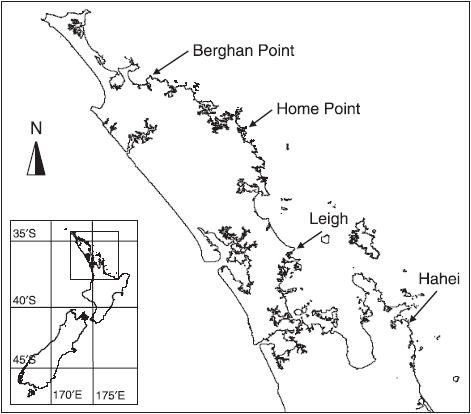A three-factor hierarchical design
We will run PERMANOVA on an example dataset consisting of assemblages of molluscs collected from holdfasts of the kelp Ecklonia radiata in a 3-factor hierarchical experimental design. There were n = 5 holdfasts collected from each of 2 areas (tens of meters apart) at each of 2 sites (hundreds of meters to kilometers apart) from each of 4 locations (hundreds of kilometers apart) in rocky reef habitats along the northeastern coast of New Zealand ( Anderson et al. (2005a) , Anderson et al. (2005b) ).
The map above shows the four locations on the northeastern coast of New Zealand from which holdfasts were collected for the study: Berghan Point, Home Point, Leigh and Hahei (reproduced from Fig. 1 in Anderson et al. (2005a) ).
The example data are found in the file called NZ holdfast fauna abundance.pri in the folder named 'NZ holdfast fauna' inside the 'Examples v7' folder that can be downloaded by clicking Help > Get Examples V7.... There were 351 taxa (rows) from 15 different phyla quantified in this study. Here, we shall focus only on the phylum Mollusca (105 taxa).
Our interest lies in quantifying the degree of turnover in the identities of mollusc species at different spatial scales, as measured by the Jaccard resemblance measure. This a fully hierarchical sampling design with three spatial factors, as follows:
- Locations (random with 4 levels: Berghan Point, Home Point, Leigh and Hahei)
- Sites (random and nested in Locations, with 2 sites per location)
- Areas (random and nested in Sites, with 2 areas per site)
Areas are therefore also (necessarily) nested in Locations as well.

